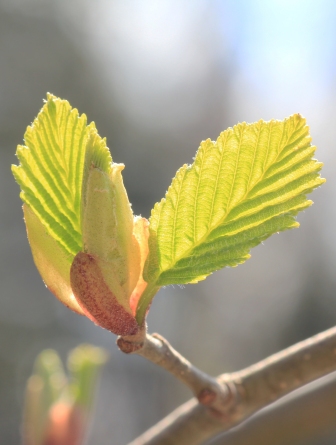Engage your students in real-world applications of STEM education using these enrichment ideas that accompany the Bursting Buds activity found in Project Learning Tree’s Explore Your Environment: K-8 Activity Guide and the PreK-8 Environmental Education Activity Guide. Be sure to check out the full activity!

As days become longer and temperatures increase, dormant leaf buds begin to stretch or elongate before revealing a tree’s new leaves. In this activity, students will observe, measure, and track this growth. They will observe trees and collect evidence to investigate how environmental factors associated with changing seasons affect leaf growth. Finally, students will construct a scientific explanation based on the evidence they collect to determine how changing environmental factors influence this growth.
Getting Started: Take your students outside to observe trees and how they grow and change in the spring. Draw their attention to the tree’s twigs and branches and have them record observations in a nature journal.
Essential Question: How does the growth of a tree respond to changing environmental conditions? (Next Generation Science Standards; MS-LS1)
Product: Students will construct a scientific explanation based on evidence for how environmental factors influence the growth of organisms. (Next Generation Science Standards; MS-LS1-5)
STEM Strategies
Science
As you observe trees with your students, ask them to share or record what the branches and twigs look like. Then, revisit the same tree as the weather warms and the days lengthen. Do the students notice any changes? Discuss how environmental factors, such as longer days and higher temperatures, influence tree and bud growth each spring. What would happen to the tree if the weather stayed cold or if it didn’t receive as much light?
Have students observe these changes over the course of a few weeks and have them describe the stages that leaf buds go through as the leaves develop. Have them pay close attention to the changes in tree buds in the spring. They may be surprised to learn that buds swell and elongate before leaves emerge from them.
Technology
It can be difficult to witness plant growth, let alone tree growth. However, students can utilize technology such as digital cameras to help them collect data and monitor leaf growth and changes. Students can even make their own time-lapse video of a bud from dormancy to elongation to leaf. The collection of photos will document the daily changes when viewed in rapid succession.
Engineering
Before flower buds open on the trees, bring in branches of one or more flowering trees, such as cherry, apple, or oak. Place cut branches in water and observe them for several days. Ask students what environmental factors have changed to cause them to bloom earlier than they would have outside. Have students design an experiment to test their theories.
Each year the National Park Service (NPS) hosts the National Cherry Blossom Festival in Washington, DC. To ensure festival visitors arrive when the trees are at peak bloom (defined as 70% of the blossoms are open), the NPS must predict when to hold the festival based on environmental factors and the trees’ responses to the changes. Have your students pretend that they work for their local park service and research, design, and test a process for determining when they should hold a blossom festival each year using a local flowering tree.
Math
As students observe the changes in buds this spring, have them measure and record the bud size from dormancy through elongation until the full leaf forms. Are dormant buds all approximately the same size or do larger buds yield larger leaves?
Additional Resources
This activity can be found in PLT’s Explore Your Environment: K-8 Activity Guide and/or PLT’s PreK-8 Environmental Education Activity Guide.
- Purchase a print guide or e-book, available from PLT.org, Amazon and other places where books are sold.
- Get it through your PLT State Coordinator along with hands-on professional development, alignments to state standards and other state-specific supporting resources.
Don’t consider yourself a formal teacher?
- Check out PLT’s Bursting Buds family activity. We have 40+ activities for families that can be easily used by parents, grandparents, youth group leaders, nature centers, and other nonformal programs.




One comment on “STEM: Bursting Buds”
I love this activity. Great way to get kids outside to observe and engage in the beauty of nature.